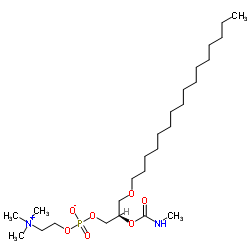Expression of the platelet-activating factor receptor results in enhanced ultraviolet B radiation-induced apoptosis in a human epidermal cell line.
L A Barber, D F Spandau, S C Rathman, R C Murphy, C A Johnson, S W Kelley, S A Hurwitz, J B Travers
Index: J. Biol. Chem. 273(30) , 18891-7, (1998)
Full Text: HTML
Abstract
Recent studies have demonstrated that ultraviolet B radiation (UVB) damages human keratinocytes in part by inducing oxidative stress and cytokine production. Severe UVB damage to the keratinocyte can also result in apoptosis or programmed cell death. Although the lipid mediator platelet-activating factor (PAF) is synthesized in response to epidermal cell damage and epidermal cells express PAF receptors, it is not known whether PAF is involved in UVB-induced epidermal cell apoptosis. These studies examined the role of the PAF system in UVB-induced epidermal cell apoptosis using a novel model system created by retroviral-mediated transduction of the PAF receptor-negative human epidermal cell line KB with the human PAF receptor (PAF-R). Expression of the PAF-R in KB cells did not affect base-line growth or apoptosis, yet resulted in a decrease in the lag time between treatment of the cells and the induction of apoptosis following irradiation with 400 J/m2 UVB. This effect was inhibited by pretreatment with the PAF-R antagonists WEB 2086 and A-85783, confirming involvement of the PAF-R in this process. At lower doses (100-200 J/m2) of UVB, only KB cells that expressed the PAF-R became apoptotic. Treatment of PAF-R-expressing KB clones with the metabolically stable PAF-R agonist 1-hexadexyl-2-N-methylcarbamoyl-3-glycerophosphocholine (CPAF) alone did not induce apoptosis but augmented the degree of apoptosis observed if CPAF was used in combination with lower doses (200 J/m2) of UVB irradiation. Interestingly, UVB irradiation was found to stimulate PAF synthesis only in PAF-R-expressing KB cell clones. The antioxidants N-acetyl cysteine, 1,1,3,3-tetramethyl-2-thiourea, and vitamin E inhibited both UVB-induced PAF biosynthesis as well as the augmentation of UVB-induced apoptosis in PAF-R-expressing KB clones, suggesting the possibility that UVB stimulates the production of oxidized lipid species with PAF-R agonistic activity in this model system. Thus, these studies indicate that a component of UVB-induced epidermal cell cytotoxicity can be modulated by PAF-R activation through the production of PAF and PAF-like species.
Related Compounds
| Structure | Name/CAS No. | Molecular Formula | Articles |
|---|---|---|---|
 |
1-O-HEXADECYL-2-N-METHYLCARBAMYL-SN-GLYCERO-3-PHOSPHOCHOLINE
CAS:91575-58-5 |
C26H55N2O7P |
|
Staphylococcal lipoteichoic acid inhibits delayed-type hyper...
2005-10-01 [J. Clin. Invest. 115(10) , 2855-61, (2005)] |
|
Platelet-activating factor biosynthesis induced by various s...
1996-07-01 [J. Invest. Dermatol. 107(1) , 88-94, (1996)] |
|
The secreted protease factor CPAF is responsible for degradi...
2006-10-20 [J. Biol. Chem. 281(42) , 31495-501, (2006)] |
|
Evidence for involvement of the epidermal platelet-activatin...
2000-08-01 [J. Invest. Dermatol. 115(2) , 267-72, (2000)] |
|
Platelet-activating factor induces collagenase expression in...
1993-09-15 [Proc. Natl. Acad. Sci. U. S. A. 90(18) , 8678-82, (1993)] |